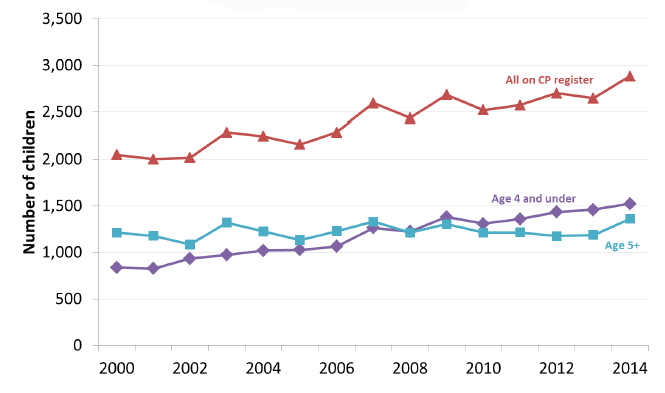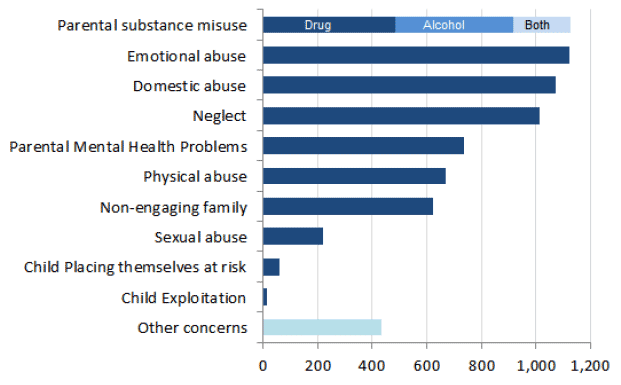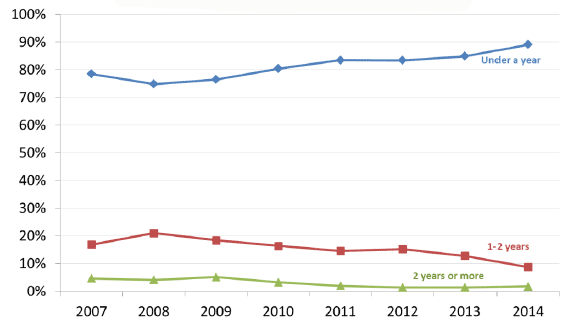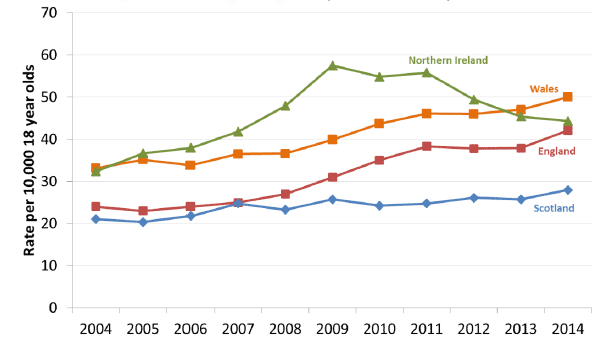Children's Social Work Statistics Scotland, 2013-14
statistics on child protection, looked after children and secure care accommodation
This document is part of a collection
Child Protection
 |
9 per cent increase from the previous year in total number on the child protection register |
 |
Continuing decrease in length of time children tend to spend on the child protection register |
 |
Children continue to be placed on the child protection register at younger ages |
This section presents data on children on the child protection register from 1 August 2013 to 31 July 2014. This will be referred to as 2014 for ease of reporting (with 2012-13 referred to as 2013 etc.). Child protection means protecting a child from child abuse or neglect. This can either be in cases where abuse or neglect has taken place, or in cases where a likelihood of significant harm or neglect has been identified. The risk of harm or neglect will be considered at a Child Protection Case Conference. Where a child is believed to be at risk of significant harm, their name will be added to the child protection register (a child protection registration).
2013-14 was only the second year that child protection data has been collected entirely at individual level. With two years of individual data, this now allows the robustness of the more detailed information to be assessed and will enable much more sophisticated analyses. Until this developmental work has been completed, this publication will continue to present high-level figures only. In future years, additional breakdowns and analysis should be available. Some of the 2012-13 figures have been revised as part of the 2013-14 validation process.
Children on the child protection register
As Chart 7 shows, the number of children on the child protection register has fluctuated but overall increased by 41 per cent between 2000 and 2014 (from 2,050 to 2,882). Following updated information from local authorities the 2013 data has been revised down slightly from the initial published figure from 2,681 to 2,645. The number of children registered in 2014 is the highest in the time series and a 9 per cent rise from 2013 - the largest year-on-year increase since 2009. It should be noted that large year-on-year changes are experienced at local authority level (see Table 2.2 for local authority level breakdowns).
Chart 7: Number of children on the child protection register by age, 2000-2014

In 2014, 53 per cent of children on the child protection register were aged under five. Since 2008 there have been more children aged under 5 than over five on the child protection register. However, in 2014, there was a much larger increase in the number of those aged 5 and over than has been seen in recent years - a 15 per cent increase from 2013.
Table 2.1: Number of children on the child protection register by gender, 2000, 2005, 2011-2014(1)
| 2000 | 2005 | 2011 | 2012(2) | 2013(2) | 2014 | % of total 2014 | Rate per 1,000 under 16s 2014(3) | |
|---|---|---|---|---|---|---|---|---|
| Boys | 1,080 | 1,098 | 1,282 | 1,335 | 1,299 | 1,406 | 49% | 3.0 |
| Girls | 970 | 1,059 | 1,209 | 1,268 | 1,220 | 1,356 | 47% | 3.3 |
| Unborns | - | - | 80 | 93 | 125 | 120 | 4% | - |
| Unknown | - | - | - | 2 | 1 | - | - | - |
| All children | 2,050 | 2,157 | 2,571 | 2,698 | 2,645 | 2,882 | 100% | 3.2 |
(1) Until 2010-11 data was collected at 31 March. From 2011 data has been collected at 31 July. Full data by gender and age group for 2000-2014 is available in Table 2.1 of the excel version of the publication tables http://www.gov.scot/Topics/Statistics/Browse/Children/PubChildrenSocialWork
(2) Revised since original publication. See background note 4.10 for more information.
(3) Source: National Records of Scotland, 2013 mid-year population estimates.
There is no strong gender pattern among children on the child protection register - 49 per cent were boys, 47 per cent were girls and the remaining four per cent were unborn children. Because of a change in how unborn children were recorded by local authorities in 2010, figures for unborn children are only comparable from 2011 onwards.
From Table 2.2 it can be seen that, in Scotland in 2014, 3.2 children in every 1,000 children under 16 were on the child protection register. This is the highest level in the time series. At local authority level the rate varied from 0.8 per 1,000 children in Scottish Borders to 5.9 per 1,000 children in Angus.
Table 2.2: Number of children on the child protection register and rate(1) per 1,000 population aged 0-15 by local authority, 2012-2014(2),
| 2012(3) | 2013(3) | 2014 | ||||
|---|---|---|---|---|---|---|
| Number | Rate | Number | Rate | Number | Rate | |
| Aberdeen City | 87 | 2.5 | 92 | 2.9 | 73 | 2.2 |
| Aberdeenshire | 73 | 1.6 | 52 | 1.1 | 68 | 1.4 |
| Angus | 59 | 3.0 | 94 | 4.7 | 116 | 5.9 |
| Argyll & Bute | 48 | 3.4 | 16 | 1.1 | 21 | 1.5 |
| Clackmannanshire | 55 | 5.8 | 32 | 3.4 | 42 | 4.6 |
| Dumfries & Galloway | 94 | 3.9 | 78 | 3.1 | 111 | 4.6 |
| Dundee City | 82 | 3.4 | 46 | 1.9 | 67 | 2.8 |
| East Ayrshire | 73 | 3.5 | 61 | 2.8 | 49 | 2.3 |
| East Dunbartonshire | 23 | 1.2 | 43 | 2.3 | 43 | 2.3 |
| East Lothian | 62 | 3.3 | 49 | 2.6 | 73 | 3.9 |
| East Renfrewshire | 36 | 1.9 | 26 | 1.5 | 32 | 1.8 |
| Edinburgh, City of | 223 | 3.1 | 262 | 3.6 | 313 | 4.2 |
| Eilean Siar | 8 | 2.5 | 14 | 3.0 | 7 | 1.6 |
| Falkirk | 73 | 2.8 | 70 | 2.5 | 85 | 3.0 |
| Fife | 205 | 3.2 | 213 | 3.3 | 230 | 3.6 |
| Glasgow City | 436 | 4.4 | 431 | 4.5 | 487 | 5.0 |
| Highland | 116 | 3.0 | 80 | 1.9 | 106 | 2.6 |
| Inverclyde | 33 | 2.4 | 24 | 1.8 | 27 | 2.0 |
| Midlothian | 117 | 7.5 | 59 | 3.8 | 54 | 3.4 |
| Moray | 45 | 3.0 | 64 | 3.8 | 45 | 2.7 |
| North Ayrshire | 74 | 3.1 | 92 | 3.8 | 108 | 4.6 |
| North Lanarkshire | 80 | 1.3 | 96 | 1.5 | 79 | 1.2 |
| Orkney Isles | 3 | 0.9 | 10 | 2.8 | 6 | 1.7 |
| Perth & Kinross | 41 | 1.5 | 49 | 2.0 | 61 | 2.5 |
| Renfrewshire | 86 | 2.8 | 109 | 3.6 | 78 | 2.6 |
| Scottish Borders | 37 | 1.9 | 25 | 1.3 | 16 | 0.8 |
| Shetland | 7 | 1.6 | 3 | 0.7 | 20 | 4.6 |
| South Ayrshire | 64 | 3.5 | 49 | 2.7 | 91 | 5.0 |
| South Lanarkshire | 165 | 2.9 | 198 | 3.6 | 174 | 3.2 |
| Stirling | 40 | 2.5 | 57 | 3.6 | 62 | 4.0 |
| West Dunbartonshire | 35 | 2.2 | 32 | 2.0 | 41 | 2.6 |
| West Lothian | 118 | 3.4 | 119 | 3.4 | 97 | 2.8 |
| Scotland | 2,698 | 3.0 | 2,645 | 2.9 | 2,882 | 3.2 |
(1) Source: National Records of Scotland, 2011-2013 mid-year population estimates.
(2) Information for all years from 2007 is included in the publication tables: http://www.gov.scot/Topics/Statistics/Browse/Children/PubChildrenSocialWork
(3) Revised since original publication. See background note 4.10 for more information.
In 2011 a combination of factors in Midlothian (such as an increase in public and professional awareness of child protection and a focus on early intervention and prevention) contributed to a substantial increase in the number of children on the child protection register (from 96 in 2010 to 158 in 2011) which was carried through to 2012. This resulted in a much higher rate than the Scotland average. Midlothian have reported that following the increased focus on early intervention the number of referrals that reach child protection registration have fallen leading to the drop in the number of children on the child protection register in both the last two years to 54 in 2014.
Since 2012 multiple concerns can be recorded at each case conference (rather than just the main category of abuse). This means that the total number of concerns is larger than the total number of registrations and that figures on concerns identified from 2012 onwards are not comparable to previous data on category of abuse/risk.
For the 2,882 children on the child protection register at 31 July 2014 there were 7,288 concerns at the case conferences at which they were registered - an average of 2.6 concerns per conference. Chart 8 shows the most common concerns identified were parental substance misuse (39 per cent), emotional abuse (39 per cent) and domestic abuse (37 per cent).
Chart 8: Concerns identified at the case conferences of children who were on the child protection register, 2014

Child protection registrations and deregistrations
The number of registrations to and deregistrations from the child protection register have both increased over the last five years. Table 2.3 shows that 17 per cent of children who were placed on the child protection register during 2013-14 had been on a child protection register before. This figure has fluctuated slightly over the past five years, but has consistently been around 16 per cent.
Table 2.3: Number of registrations following an initial, pre-birth or transfer-in case conference by length of time since previous deregistration, 2008, 2010, 2013-2014(1)
| Time since last deregistration | Year to 31 March | Year to 31 July | % of total 2014(2) | ||
|---|---|---|---|---|---|
| 2008 | 2010 | 2013 | 2014 | ||
| Never been registered before | 2,355 | 2,971 | 3,574 | 3,814 | 83% |
| Registered before but time unknown | 5 | 0 | 1 | 1 | 0% |
| Less than 6 months | 95 | 81 | 114 | 108 | 2% |
| 6 months - < 1 year | 68 | 98 | 88 | 101 | 2% |
| 1 year - < 18 months | 48 | 67 | 73 | 94 | 2% |
| 18 months - < 2 years | 53 | 60 | 54 | 98 | 2% |
| 2 years or more | 181 | 269 | 318 | 361 | 8% |
| Not known if been registered before | 9 | 5 | 29 | 27 | |
| Proportion of registrations to children who had been registered before(2) | 16% | 16% | 15% | 17% | |
| Total | 2,814 | 3,551 | 4,251 | 4,606 4,270 | 100% |
(1) Information back to 2007 is included in the excel version of the publication tables: http://www.gov.scot/Topics/Statistics/Browse/Children/PubChildrenSocialWork
(2) Excludes cases where it is not known if a child had been registered before.
As Chart 9 shows that, while there is an increase in number of children registered, the length of time for which children are registered has been decreasing since 2008. In 2014, 89 per cent of deregistrations were for children who had been registered for less than a year, compared to 75 per cent in 2008. In combination with the fall in the age of children on the child protection register, this suggests that children are being registered at earlier ages for shorter periods of time.
Chart 9: Percentage of deregistrations by length of time on the child protection register, 2007-2014

Table 2.4 shows the ongoing increase in deregistrations. There were 4,327 deregistrations from the child protection in the year to 31 July 2014, a two per cent increase on 2013 and a 35 per cent increase on 2008. The most common reason for deregistration in 2013-14 (in 50 per cent of cases) was an improved home situation.
Table 2.4: Number of deregistrations from the child protection register by length of time on register and reason for deregistration, 2008, 2010, 2013-2014(1)
| Year to 31 March | Year to 31 July | % of total 2014 | % change 2013-2014 | |||
|---|---|---|---|---|---|---|
| 2008 | 2010 | 2013 | 2014 | |||
| Length of time registered | ||||||
| Less than 6 months | 1,245 | 1,592 | 2,012 | 2,445 | 56% | 22% |
| 6 months to under 1 year | 1,148 | 1,483 | 1,576 | 1,412 | 33% | -10% |
| 1 year to under 18 months | 470 | 460 | 409 | 248 | 6% | -39% |
| 18 months to under 2 years | 202 | 168 | 132 | 131 | 3% | -1% |
| 2 years or more | 132 | 123 | 58 | 76 | 2% | 31% |
| No date of registration | 41 | 21 | 1% | |||
| Reason for deregistration | ||||||
| Child taken into care & risk reduced | 411 | 538 | 617 | 664 | 15% | 8% |
| Child with other carers | 218 | 275 | 322 | 327 | 8% | 2% |
| Child died | 4 | 4 | 8 | 5 | 0% | -38% |
| Removal of perpetrator | 112 | 81 | 123 | 106 | 2% | -14% |
| Improved home situation | 830 | 1,220 | 2,136 | 2,179 | 50% | 2% |
| Child automatically de-registered due to age | 12 | 8 | 7 | 15 | 0% | 114% |
| Child moved away - no continued risk | 24 | 26 | 21 | 48 | 1% | 129% |
| Other reason(2) | 1,586 | 1,674 | 993 | 988 | 23% | -1% |
| Reason not known | - | - | 1 | 1 | ||
| Total | 3,197 | 3,826 | 4,228 | 4,333 | 100% | 2% |
(1) Information for all years back to 2007 is included in the excel version of the publication tables: http://www.gov.scot/Topics/Statistics/Browse/Children/PubChildrenSocialWork
(2) This category was called reduced risk (other) prior to 2012.
Cross-UK child protection comparisons
Child protection systems across the United Kingdom vary but are generally comparable. Scotland's collection year runs from 1 August to 31 July, so end‑year figures are reported at 31 July, while the collection year in England, Wales and Northern Ireland runs from 1 April to 31 March (so end-year figures are at 31 March). In future years, when the individual level child protection collection is more established, it will be possible to provide a 31 March figure for Scotland as well. The cross-UK figures are given as a proportion of under 18s in each country, while the other child protection rates in this chapter are given as a proportion of under 16s.
Chart 10: Cross-UK comparison of the rate of children on the child protection register per 10,000 under 18s, 2004-2014

While Scotland has seen an increase in the rate of registrations to the child protection register over the last decade, it is not as steep as the increase in England and Wales over the same period and remains at the lowest rates across the UK. Scotland, England and Wales all experienced a larger increase in rate of registrations in 2014 than in the previous few years. Northern Ireland has seen a different pattern to the other three UK countries, with a very sharp decrease in the rates of children on the child protection register which peaked in 2009 and has declined since then.
There are links to the cross-UK data underlying Chart 10 in Background Note 1.8 and more information on the comparability of child protection data across the UK here: http://www.gov.scot/Topics/Statistics/Browse/Children/socialservicestats
Additional tables on child protection are available at: http://www.gov.scot/Topics/Statistics/Browse/Children/PubChildrenSocialWork
Contact
Email: Ian Volante
There is a problem
Thanks for your feedback